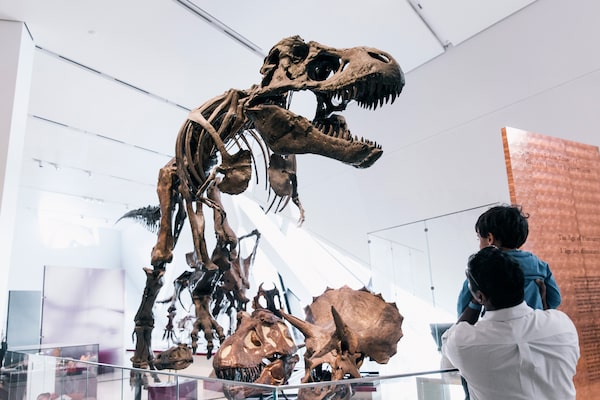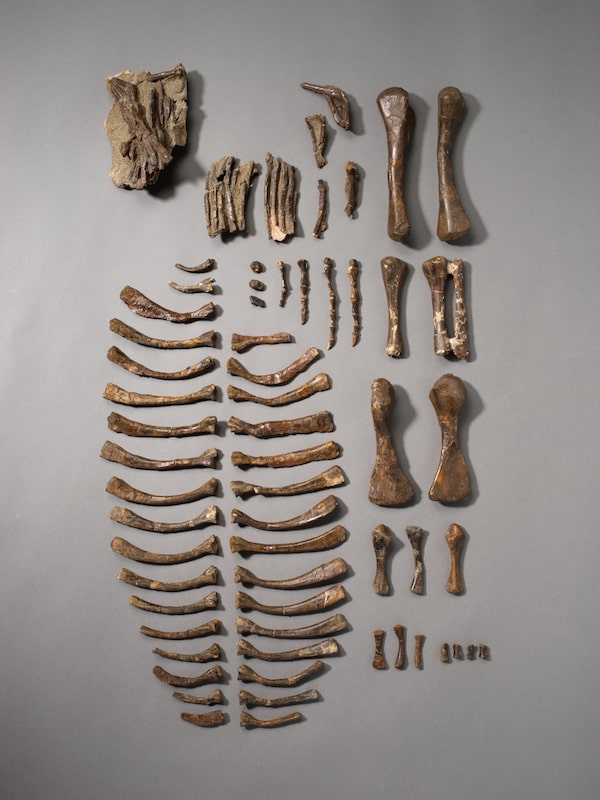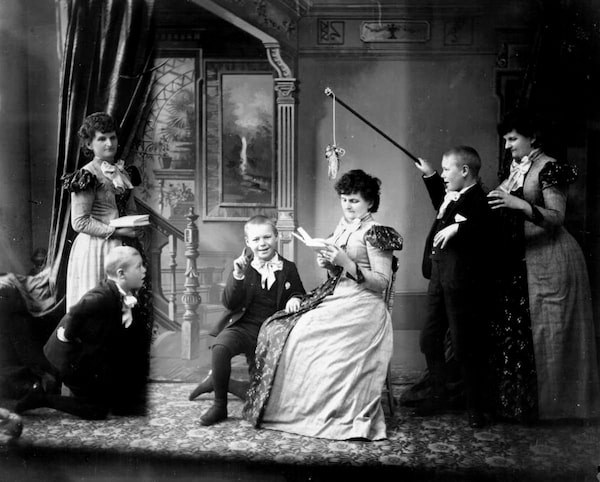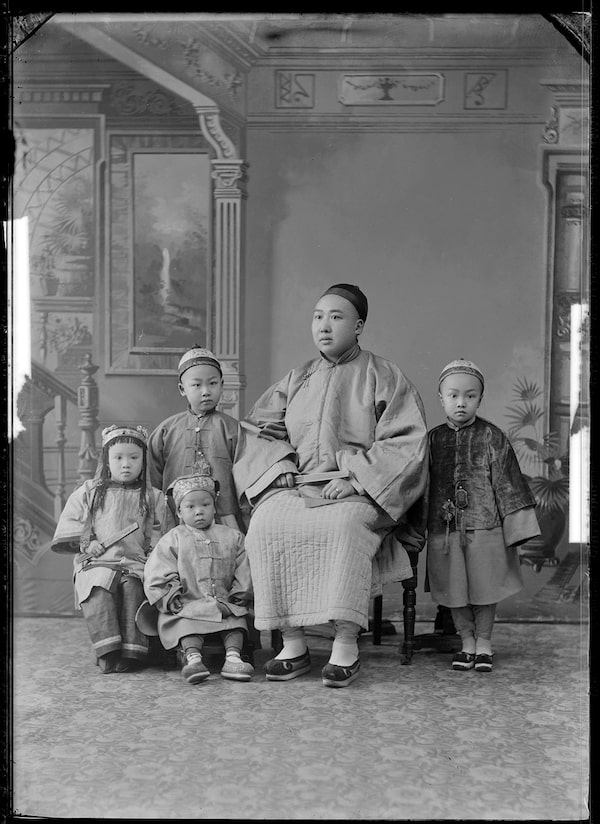
This tyrannosaurus rex skeleton is presently on display in the James and Louise Temerty Gallery of the Age of Dinosaurs at ROM, where this photo was taken.ROM
If you are restless these days, you could escape to a Group of Seven landscape beckoning from the website of the Art Gallery of Ontario or McMichael Canadian Art Collection. If the kids are hollering, you could distract them with dinosaurs and fossils available online courtesy of the Royal Ontario Museum or Royal B.C. Museum.
Forced to close by the coronavirus crisis, Canada’s museums and public art galleries quickly redirected visitors to their digital offerings: social-media feeds, 3-D gallery tours, videos of curators’ talks, online exhibitions and image banks of their collections. Virtual experiences beckon, yet the truth is that only a tiny fraction of Canada’s public collections can be seen online.
Digital resources can let visitors access cultural heritage remotely, but they are expensive; big institutions use them selectively while many smaller ones can barely afford them at all. Meanwhile, museum professionals debate whether they should be storytelling or vault-opening – creating focused online exhibitions or accessible archives of their treasures.
“The immediate response [to the closures] is ‘You’ll create these wonderful digital experiences.’ It’s a rhetorical response: Oh, you just go online,” said Zainub Verjee, executive director of the Ontario Association of Art Galleries. She cautions there are large differences between curating an Instagram account or setting up a 3-D tour and maintaining online collections. “If it’s that simple, every museum and art gallery collection in the world would be online.”
Of course, many of the world’s art treasures – from abstract expressionist paintings to Ming vases – can be found with a few keystrokes, but scratch the surface of museum databases and you discover their limits. Most museums and public art galleries, particularly the larger ones, exhibit a small fraction of what they hold and their online image banks tend to reflect highlights that are on view in the physical museum. In 2016, the Canadian Museums Association estimated that only two per cent of Canada’s public art and artifacts had been digitized.
The Royal Ontario Museum in Toronto, for example, displays about 35,000 of the 13 million art objects, artifacts and scientific specimens that it holds; online, it offers slightly more, 46,500 items – a generous taste for a casual visitor but less than half a per cent of the actual collection.

This champsosaur specimen is presently not on display, and is stored in the ROM vertebrate paleontology collections.Tina Weltz/ROM
“We want to have a high-quality image for each of the objects we publish online as well as accurate and meaningful collections information. We are not taking the track that we are just opening the portal and dumping everything that we have,” said Shyam Oberoi, chief digital officer. The ROM’s current goal is to add 20,000 objects a year to the website and to introduce the public to more material not on display.
The limit is cost. It requires expensive software, cameras and scanners, but most of all it requires time – to streamline the scholarly systems used to catalogue collections, to assemble data about each piece and to photograph it.
And, if the object is the work of a living artist or one who died less than 50 years ago, museums also have to negotiate and pay copyright fees. That’s why contemporary art is poorly represented on their websites.
All this makes the job particularly onerous for small institutions, such as community museums or university art galleries, with limited staff or digital capacity: When the Ontario Association of Art Galleries surveyed its members about the impact of the current closures, about a third said they had no ability to move content online.
“Some are so small-scale, it’s somebody sitting at home trying to figure out what to do,” Verjee said, calling on the Ontario government to set up a digital fund to help museums respond.
Smaller institutions used to rely on federal help to build their digital capacity but that has shrunk. In the 2000s, the early years of digitizing collections, Canada was considered a pioneer. It built Artefacts Canada, a federal database of museum collections and launched the Virtual Museum of Canada as its public face. The dream was that geography would not be a barrier between Canadians and their museums.
Then, in 2014, the Conservative government made deep cuts to the Canadian Heritage Information Network that runs Artefacts Canada and transferred the Virtual Museum to the Canadian Museum of History in Gatineau, Que.

This whimsical image seems to have been made by magic. If you look closely you can see a dark edge on the left side of the photo and how the image has been divided into thirds. This is where some of the illusion lives. Hannah may have taken these photos by covering two thirds of the lens and exposing each third to light one at a time. This created the hard lines. [ca. 1895] The boy in the photo is Maynard McDonald, Hannah's grandson. Maynard moved in with his grandparents after his mother, Emma (Hannah Maynard's daughter), passed away in 1888.Royal BC Museum and Archives/Royal BC Museum and Archives
“We were leaders; we had a system that worked and we absolutely lost it,” said Vanda Vitali, executive director of the Canadian Museums Association.
Today, Artefacts Canada remains a government-issue database that includes one million images, but is unlikely to engage the lay person. In contrast, the British website Art UK offers an elegant and user-friendly online survey of that nation’s cultural heritage. Meanwhile, the Virtual Museum of Canada is now run as a funding program to help institutions mount their own online exhibitions, which it then also hosts at virtualmuseum.ca. Some current examples include the Musée du Haut-Richelieu’s photography show about the 1998 ice storm in Quebec and stories of wartime radar workers from The Secrets of Radar Museum in London, Ont.
That stress on storytelling is typical of how many institutions appeal to online visitors, with the focus on offering virtual exhibitions. Toronto’s Art Gallery of Ontario, for example, hosts a digital version of its popular 2016-17 show of medieval boxwood miniatures that used scanning technology to discover how these impossibly tiny carvings were made. It also offers an online exhibition of Henryk Ross’s wartime photographs of the Lodz Ghetto in Poland.
That 4,000-photograph archive is an example of why it’s important to offer online access to artifacts that aren’t physically available. The fragile collection is of interest to Holocaust researchers, students, survivors and their descendants, and its digitization can claim some remarkable achievements: It allowed one family to find the only existing photograph of its grandmother.
Rather than offering visitors specific exhibitions, some museums prefer to let the public make its own way through online collections and, as the Lodz example shows, crowd-sourcing can have an important role in connecting communities and museums.
That’s the approach in Nova Scotia, where in 2002, the Association of Nova Scotia Museums launched a co-operative website to which local museums can post material, a model that has since been adopted by several other provinces.
Today, NovaMuse covers the collections of 50 museums from the Cape Sable Historical Society to the North Highlands Community Museum in Cape Breton. The project uses free open-source software and encourages contributions from the community, where long memories or special expertise may offer up new information.
“If we have things, we should not be hiding them, but showing them off. It’s a patchwork quilt coming together,” said Karin Kierstead, who oversees the program.

This portrait was taken in Mrs. R. Maynard's Photographic Gallery. Hannah Maynard's clientele included customers of East Asian and Chinese heritage.Royal BC Museum and Archives/Royal BC Museum and Archives
Still, the public has high expectations: Following its open-door policy, NovaMuse simply includes written entries for the many artifacts that haven’t been photographed, but Kierstead is often asked by puzzled users why there isn’t an image.
Another debate among museums is to what extent their websites should be encouraging visitors to copy and repurpose the images they find there. Museums have traditionally asserted their rights over their collection photography, even for historic works that are in the public domain, but there’s movement to make images more easily available.
Museums around the globe are making a concerted effort to assess what the public can freely retrieve, reuse, and remix from their websites,” said Oberoi at the ROM. “This is how you reach those audiences who are never going to come to the museum.”
Yet he and his colleagues all agree nothing can replace a visit.
“The first thing you see when you enter the museum is the dinosaur. There is no way you can replicate that online,” he said. “You can have a digital experience but it doesn’t replace physically standing underneath it. It’s also true of any work or art: the in-person experience can’t be replicated.”
It’s a sobering thought as all museums remain firmly closed.
AGO, examples of the Boxwood Project. Last Judgement; Coronation of the Virgin, 1500-1530. Boxwood with metal fittings, Overall Closed: 5.9 × 6.1 cm. The Thomson Collection at the Art Gallery of Ontario, Toronto.Ian Lefebvre/Art Gallery of Ontario
Highlights of Canadian museums online
Forced to close by the COVID-19 crisis, Canadian museums and public art galleries have posted a wide selection of new material, including video talks, suggested art and education projects, and digital galleries. Meanwhile, their existing online offerings already included selections from their collections and virtual exhibitions. Here’s a small sampling of what’s available.
The Virtual Museum of Canada features more than 100 online exhibitions and more than 500 community stories from museums and art galleries across the country. They include everything from a 3-D tour of Monastery of the Ursulines in Quebec City to videos and photography of the Kwakwaka’wakw potlatch ceremonies on British Columbia’s Northwest coast.
NovaMuse is both an online hub leading to the websites of 50 Nova Scotian museums and a searchable data base of their collections. Check out everything from a miner’s respirator (the Malagash Salt Mine Museum) to a 19th-century wedding dress in brilliant chartreuse (Yarmouth County Museum).
The Montreal Museum of Fine Arts is offering daily art projects, art-based meditations and curators’ talks at its website and on social media. Make your own still-life, reflect on the power of the circle or tour 10 works of art that focus on the human body.
The Art Gallery of Ontario has turned its homepage into an AGO At Home hub including links to articles, videos of artists’ and curators’ talks, and images of its collection. Its deeper digital work is in the Collections in Focus area. It includes online exhibitions such as the Boxwood Project investigating the construction of medieval miniatures and the Lodz Ghetto Photographs of Henryk Ross taken during the Second World War.
The Aga Khan Museum in Toronto has organized #Museumwithoutwalls which includes performances and views of the collection, including a curator’s tour of the upcoming Sanctuary exhibition. Its prescient theme is the meaning of sanctuary and it features rugs made by Pakistani artisans using traditional techniques but new designs provided by 36 contemporary artists, including Mona Hatoum, Brendan Fernandes and Ai Weiwei.
Contemporary Calgary has launched Art Where You Are which includes an intriguing interview with British artist Luke Jerram, whose Museum of the Moon was on display when the gallery closed. He talks about his art as well as tides, microbiology and COVID-19.
Google Arts & Culture offers highlights from museum collections around the world, including about a dozen Canadian institutions. Its most impressive Canadian entry is the 3-D tour of the Vancouver Art Gallery. Douglas Coupland’s 2014 exhibition Everywhere Is Anywhere Is Anything Is Everything figures prominently and feels newly topical: It’s a discussion of global ubiquity and local identity.
Royal BC Museum’s online learning portal offers photos, videos and articles organized as pathways through the province’s natural and cultural history. Watch palaeontologists at work in the McAbee fossil beds in the Thompson River Valley or browse through the intriguing images of 19th-century Victoria and its inhabitants taken by pioneering B.C. photographer Hannah Maynard.
Queen of Sheba Visiting King Solomon; Adoration of the Magi, 1500-1530. Boxwood with metal fitting, Overall Closed: 5.5 × 6.4 cm. Overall Open: 5.9 × 5.9 × 12.2 cm. The Thomson Collection at the Art Gallery of Ontario.Art Gallery of Ontario
Find out what’s new on Canadian stages from Globe theatre critic J. Kelly Nestruck in the weekly Nestruck on Theatre newsletter. Sign up today.